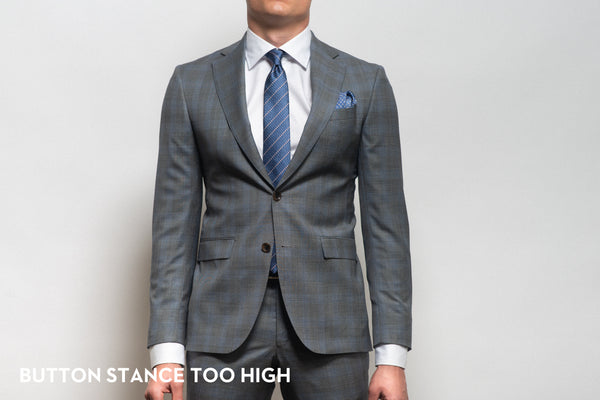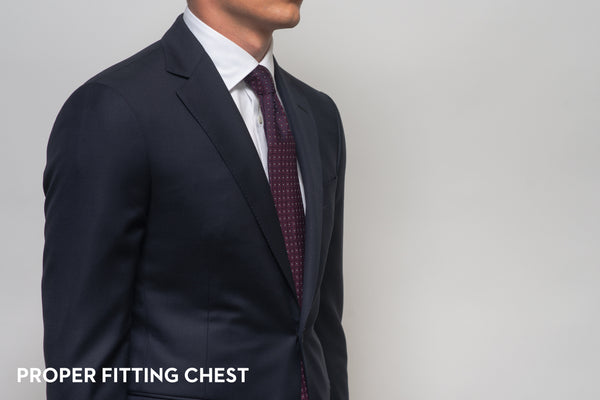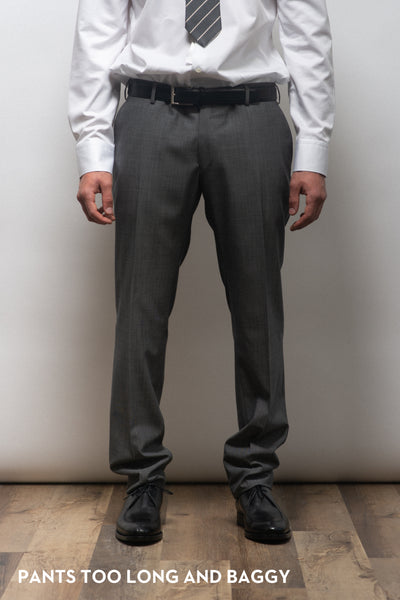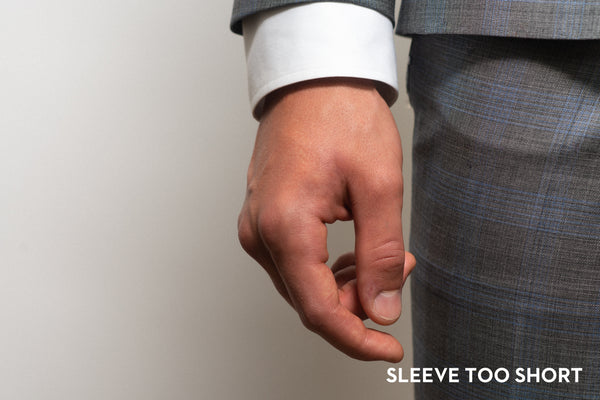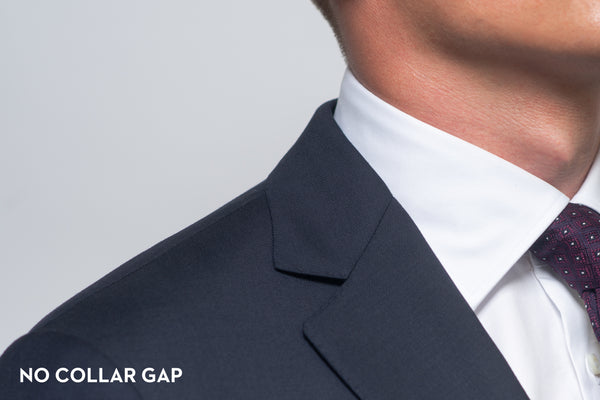How your suit should actually fit
There are always going to be online lists pointing out the dos and don’ts of suit etiquette. They often outline a very basic right and wrong, black and white opinion on how a suit should look based on the current state of men's fashion. They usually speak to a suit-buying customer who’s in the market for their first garment. Suit 101, entry-level stuff.
Their opinions aren't always wrong, but they usually miss crucial points about the importance of fit, and especially what makes a bad fit. It's one thing we find people are most uncertain about, so we've identified some of the finer details to watch for when determining whether or not a suit actually fits you properly. We also tell you the best way to fix the issue.
These are timeless rules that are won't change as suit styles evolve, so memorize them, bookmark the post, do whatever you've got to do to make sure you're never wearing a poor-fitting suit again.
These are The Helm’s Top Ten Signs You’re in a Poor-Fitting Suit
1. Jacket shoulder sag/bite
When trying on a suit jacket or blazer, the first thing you should look at is the shoulder.
There are a couple of major signs that the suit you’re wearing isn't the right fit: shoulder sag and shoulder bite. Both are bad, but sag is the greater of the two evils. These sins occur when the jacket’s shoulder width doesn’t match the shoulders of the wearer.
When the shoulders/armholes of a suit or sport jacket are too tight, you get a divot on the arm towards the back of the sleeve head, known as bite.
When the shoulders are too wide you end up with shoulder sag – the '90s Chicago banker look. You know what we mean.
A jacket should fall clean off your shoulder, with just a slight amount of shoulder coming out beyond the armhole.
How to fix it: If you notice shoulder sag or bite when trying on a jacket, it's best to try a different size or go the custom route. A tailor can fix it to some degree, but it's difficult to adjust and will probably be expensive.
2. The jacket's front button stance is too high and pops
Button stance has been a long-debated topic in the menswear scene. Many of today’s ready-to-wear jackets have a mid-to-high button stance, especially from contemporary Italian clothing manufacturers.
A higher button stance can look quite casual and trendy when worn properly, but when it’s too tight the result is terrible – especially if the wearer’s sporting a bit of a belly.
The higher the button stance, the shorter your torso will look when the jacket is done up. This is fine if you are on the shorter side and want to lengthen the appearance of your legs, but it can make you look off-balance otherwise.
The top button on a two-button suit should hover between 1-3 fingers above the belly button and will pull slightly when done up (depending on the look the wearer is going for). If it is too high and tight, it will "pop" or pull too aggressively.
How to fix it: Sizing up or down or choosing a different style or brand is your best bet here. If nothing satisfies, try something custom.
3. The jacket's chest breaks/gapes
The chest of a suit or sport jacket should always follow the shape of the wearer's chest.
A gaping coat chest is not a good look and neither is chest break. A chest break usually happens when the jacket is too small, and chest gape usually happens when it's too big. Either way, it results in a gap between the chest and the jacket. It can also have to do with where the shoulder is sitting in general.
How to fix it: If either of these issues is evident when trying on ready-to-wear garments, try going up or down a size first. If this doesn't fix it, you should consider custom options to correct the problem rather than trying to get it tailored.
4. The suit jacket is too long or short
Shorter jackets are trendy, but don't take it too far. And if you’re still wearing jackets down to your fingertips, you need to correct that situation as well!
Your suit jacket should cover about 80% of your butt and crotch.
Generally, the bottom edge of a jacket should end between the two knuckles on your thumb. This rule can be pushed a little bit when wearing a casual sport coat because they tend to be a little shorter.
How to fix it: Getting a jacket shortened or lengthened by a tailor is usually not possible. Try sizing up or down first, and then discuss with your sales associate to see if tailoring or custom is the better route for you.
5. The pant has a tight or saggy seat
It's not uncommon for the seat to be too tight or too saggy, depending on how athletic you are or the build of your bottom half. The seat should be smooth against your derriere without pulling. If it feels like they're going to split when you sit, it's time to size up.
How to fix it: Tailors can fix a saggy seat very easily. If your pants are too loose in the back, get it taken in. If it's too tight, your best bet is to size up. A tailor can usually only let out a pair of dress pants by a maximum of one inch.
6. The pant pockets pop like elephant ears
This is a tough one because it's not easily solved with a quick trip to the tailor. The pockets on a trouser should lay flat and clean against the side of a man’s hip. If they pop, your pants don’t fit like they should!
Popping pockets occur when the seat is too tight or the stride doesn’t offer enough thigh room. The tighter the fit, the bigger the pop. This is an important issue to watch for.
How to fix it: Try sizing up first. If you have a hard time finding trousers that don't give you the pocket pop issue, your best bet is to go the custom route.
7. The jacket collar rolls behind the neck
Collar roll. The worst! But this is something that a good tailor can correct.
Collar roll happens on a suit for two reasons--either the posture of the wearer doesn't match the slope of the jacket or the person has high shoulders. It's more common than you would think but it's also something many people don't know to watch for.
How to fix it: Get it tailored. Collar roll is a common fix that usually just involves adjusting the slope of the shoulder.
8. The pants have a '90s Chicago banker look
A friend of ours was in Chicago on vacation not too long ago and snapped a photo of some business guy having drinks in the Financial District. Not to rip on Americans for their poor fashion sense, but the guy in the photo looked comical. His suit looked to be circa 1994: super long jacket and trousers. Don't get caught looking like a '90s Chicago banker!
Your trousers should fit clean through the thigh and somewhat narrow at the bottom – relative to your build. They should also fall clean against your shoe, with a very slight break in the front. Trousers should never ever break at the back of the shoe.
How to fix it: Size down if they are too baggy all around, or get a tailor to hem them and/or take them in. Most dress pants come unhemmed, so they have to be hemmed when you first buy them anyway. Make sure your tailor knows you only want a single break. If they aren't quite right, re-hemming them is an easy fix.
9. The jacket sleeves are covering your knuckles
The sleeve of your suit jacket should rest just above the hinge where your hand meets your wrist. If all of your jackets are tailored to this point and your shirts fit properly, you’ll always show the proper amount of shirt cuff, which should be between 1/4" - 1/2".
How to fix it: Sleeve length is another easy fix. If the jacket fits everywhere other than the sleeves, get the sleeves tailored. A tailor can usually shorten or lengthen a sleeve by up to an inch either way. If you need more than this, a made-to-measure option is best.
10. The dreaded collar gap!
This is the #1 cardinal sin in tailored clothing! It's not something most people know to look for, but the collar gap is a telltale sign that you are wearing the wrong jacket. This is where there's a space between the collar of your jacket and the collar of your shirt.
Your jacket collar should always lay clean and tight against the back of your neck. Sometimes it’s a sizing issue and sometimes it’s a balance issue. Whatever the case, make sure it doesn’t happen to you!
How to fix it: If the gap is small a tailor might be able to fix it, though this can be a relatively expensive alteration. Instead, we suggest sizing up or down or trying a different brand. If this is a common issue for you, custom suits are probably your best bet.
--
As a quick recap, here are the signs your suit doesn't fit:
- The jacket shoulders sag or bite
- The button pulls or the button stance is higher than 1-3 fingers above your belly button
- The jacket chest gapes open or breaks
- The jacket doesn't cover around 80% of your butt
- The trouser seat isn't smooth
- The pants pockets pop outward
- You have a collar roll behind the neck
- The pant leg breaks at the back of the shoe or doesn't cover the back of the shoe at all
- The jacket sleeves show more or less than 1/4"-1/2" of shirt cuff
- You have collar gap, and the jacket collar doesn't lay clean against the back of your neck.
These are the top things to look for when buying fine tailored clothing. By following these ten guidelines you’re bound to look sharp. If any of these ill-fitting suit gaffes apply to a garment you are currently wearing, you know who to contact. (It's us. Email us.)




